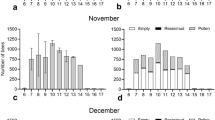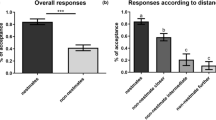Abstract
Honeybees are attracted to a variety of odors, including the secretion of their Nasonov glands, a secretion that has been widely assumed to be an orientation and attraction pheromone. A crossover design experiment comparing synthetic Nasonov secretion with linalool, oil of clove, skatole, and wax moth sex pheromone was established to determine if Nasonov secretion serves as a true pheromone or is simply a general attractant for honeybee swarms. None of the test odors was more attractive than odorless controls, and in all comparisons, synthetic Nasonov secretion was significantly more attractive than the test odors or odorless controls. The results confirm that Nasonov secretion is a true pheromone in the context of attracting honeybee swarms to nest cavities and that environmentally present or apparent odors play little or no role in honeybee nest-seeking behavior.
Similar content being viewed by others
REFERENCES
Dickens, J. C., Eischen, F. A., and Dietz, A. 1986. Olfactory perception of the sex attractant pheromone of the greater wax moth, Galleria mellonella L. (Lepidoptera: Pyralidae), by the honey bee, Apis mellifera L. (Hymenoptera: Apidae). J. Entomol. Sci. 21:349-354.
Free, J. B. 1987. Pheromones of Social Bees, Cornell University Press, Ithaca, New York.
Free, J. B., Ferguson, A. W., Pickett, J. A., and Williams, I. H. 1982. Use of unpurified Nasonov pheromone components to attract clustering honeybees. J. Apic. Res. 21:26-29.
Pickett, J. A., Williams, I. H., Martin, A. P., and Smith, M. C. 1980. Nasonov pheromone of the honeybee, Apis mellifera L. (Hymenoptera: Apidae). Part I. Chemical characterization. J. Chem. Ecol. 6:425-434.
Schmidt, J. O. 1994. Attraction of reproductive honeybee swarms to artificial nests by Nasonov phermone. J. Chem. Ecol. 20:1053-1056.
Schmidt, J. O., and Thoenes, S. C. 1987. Swarm traps for survey and control of Africanized honey bees. Bull. Entomol. Soc. Am. 33:155-158.
Schmidt, J. O., Thoenes, S. C., and Hurley, R. 1989. Swarm traps. Am. Bee J. 129:468-471.
Snedecor, G. W. 1956. Statistical Methods. Iowa State University Press, Ames, Iowa.
Wells, P., Wells, H., Yu, N., Vadehra, N., Lee, C., Han, R., Han, K., and Chang, L. 1993. Does honeybee Nasonov pheromone attract foragers? Bull. S. Calif. Acda. Sci. 92:70-77.
Wenner, A. M., and Wells, P. H. 1990. Anatomy of a Controversy. Columbia University Press, New York.
Author information
Authors and Affiliations
Rights and permissions
About this article
Cite this article
Schmidt, J.O. Attractant or Pheromone: The Case of Nasonov Secretion and Honeybee Swarms. J Chem Ecol 25, 2051–2056 (1999). https://doi.org/10.1023/A:1021084706241
Issue Date:
DOI: https://doi.org/10.1023/A:1021084706241




